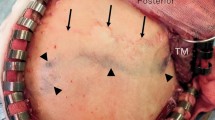Abstract
Background and purpose
An occipital sinus draining into the sigmoid sinus has been termed the oblique occipital sinus (OOS). The frequency, anatomical features, patterns, and relationship with the transverse sinus of the oblique occipital sinus were analyzed in this study.
Materials and methods
The study included 1805 patients who underwent brain CT angiography during a 3-year period from 2013 to 2015. CT examinations were performed using a 64-slice MDCT system.
Results
The OOS was identified in 41 patients (2.3%). There were many anatomical variations in the oblique occipital sinuses. A hypoplastic or aplastic TS was seen in 31 (75.6%) of the 41 patients with OOS.
Conclusion
Many anatomical variations in the oblique occipital sinus can be seen on CT venography. Some OOSs function as the main drainage route of the intracranial veins instead of the TS. Thus, careful examination is essential for preoperative evaluation in posterior fossa lesions.











Similar content being viewed by others
References
Alper F, Kantarci M, Dane S, Gumustekin K, Onbas O, Durur I (2004) Importance of anatomical asymmetries of transverse sinuses: an MR venographic study. Cerebrovasc Dis 18:236–239
Ayanzen RH, Bird CR, Keller PJ, McCully FJ, Theobald MR, Heiserman JE (2000) Cerebral MR venography: normal anatomy and potential diagnostic pitfalls. AJNR Am J Neuroradiol 21:74–78
Das AC, Hasan M (1970) The occipital sinus. J Neurosurg 33:307–311
Dora F, Zileli T (1980) Common variations of the lateral and occipital sinuses at the confluens sinuum. Neuroradiology 20:23–27
Gokce E, Pinarbasili T, Acu B, Firat MM, Erkorkmaz U (2014) Torcular Herophili classification and evaluation of dural venous sinus variations using digital subtraction angiography and magnetic resonance venographies. Surg Radiol Anat 36:527–536
Hacker H (1974) Normal supratentorial veins and dural sinuses. Radiology of Skull and Brain. Angiography. 3:1851–1877
Kobayashi K, Koda W, Sugihara M, Suzuki M, Ueda Matsuio O (2003) Prominent occipital sinuses having direct communication with straight sinuses. Rivista di Neuroradiologia 16:1205–1207
Kobayashi K, Suzuki M, Ueda F, Matsui O (2006) Anatomical study of the occipital sinus using contrast-enhanced magnetic resonance venography. Neuroradiology 48:373–379
Kobayashi K, Matsui O, Suzuki M, Ueda F (2006) Anatomical study of the confluence of the sinuses with contrast-enhanced magnetic resonance venography. Neuroradiology 48:307–311
Liang L, Korogi Y, Sugahara T et al (2001) Evaluation of the intracranial dural sinuses with a 3D contrast-enhanced MP-RAGE sequence: prospective comparison with 2D-TOF MR venography and digital subtraction angiography. AJNR Am J Neuroradiol 22:481–492
Tubbs RS, Bosmia AN, Shoja MM, Loukas M, Cure JK, Cohen-Gadol AA (2011) The oblique occipital sinus: a review of anatomy and imaging characteristics. Surg Radiol Anat 33:747–749
Wetzel SG, Kirsch E, Stock KW, Kolbe M, Kaim A, Radue EW (1999) Cerebral veins: comparative study of CT venography with intraarterial digital subtraction angiography. AJNR Am J Neuroradiol 20:249–255
Widjaja E, Griffiths PD (2004) Intracranial MR venography in children: normal anatomy and variations. AJNR Am J Neuroradiol 25:1557–1562
Author information
Authors and Affiliations
Corresponding author
Ethics declarations
We declare that all human and animal studies have been approved by the Gyeongsang National University Hospital Institutional Review Board and have therefore been performed in accordance with the ethical standards laid down in the 1964 Declaration of Helsinki and its later amendments. We declare that all patients gave informed consent prior to inclusion in this study. None of the authors have any financial and personal relationships with other people or organizations that could inappropriately influence the work.
Conflict of interest
The authors declare that they have no conflict of interest.
Rights and permissions
About this article
Cite this article
Shin, H.S., Choi, D.S., Baek, H.J. et al. The oblique occipital sinus: anatomical study using bone subtraction 3D CT venography. Surg Radiol Anat 39, 619–628 (2017). https://doi.org/10.1007/s00276-016-1767-x
Received:
Accepted:
Published:
Issue Date:
DOI: https://doi.org/10.1007/s00276-016-1767-x




